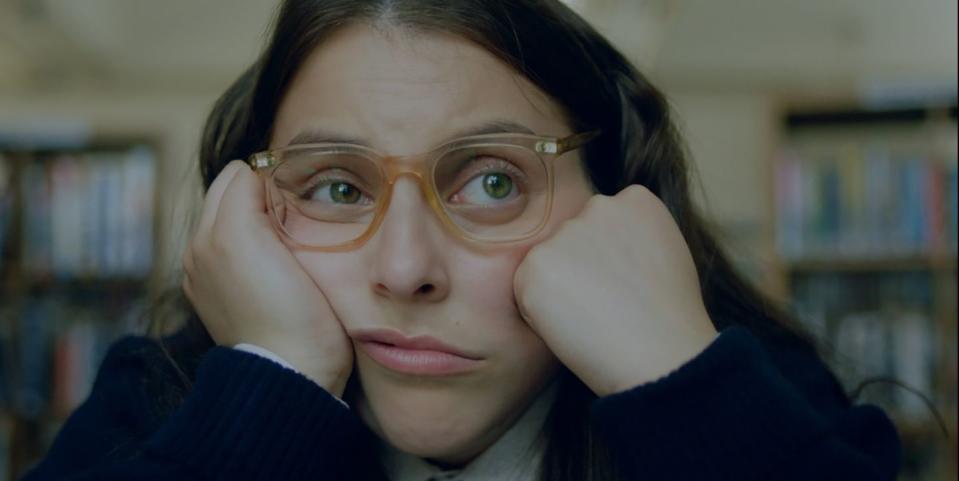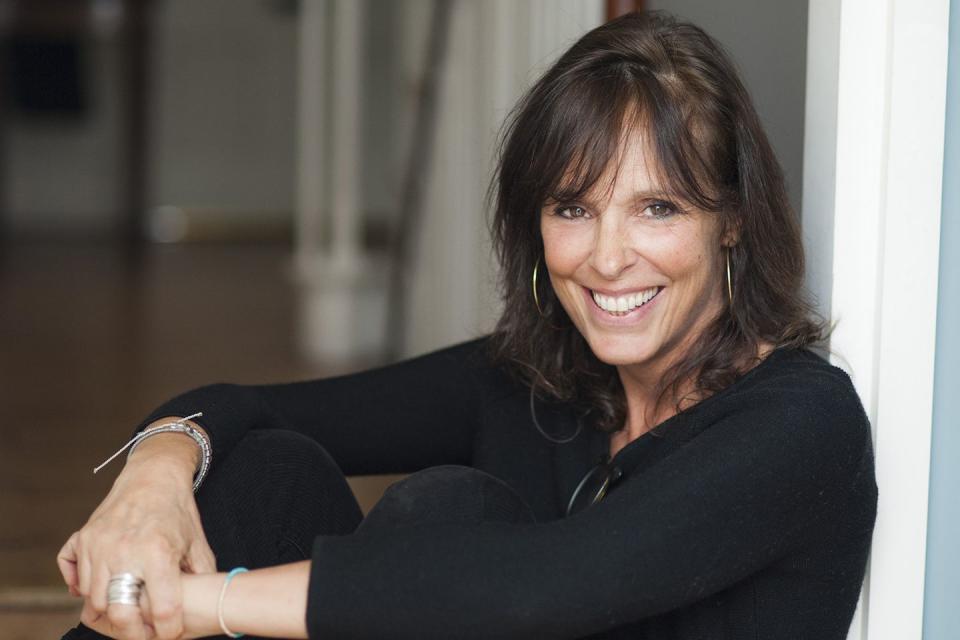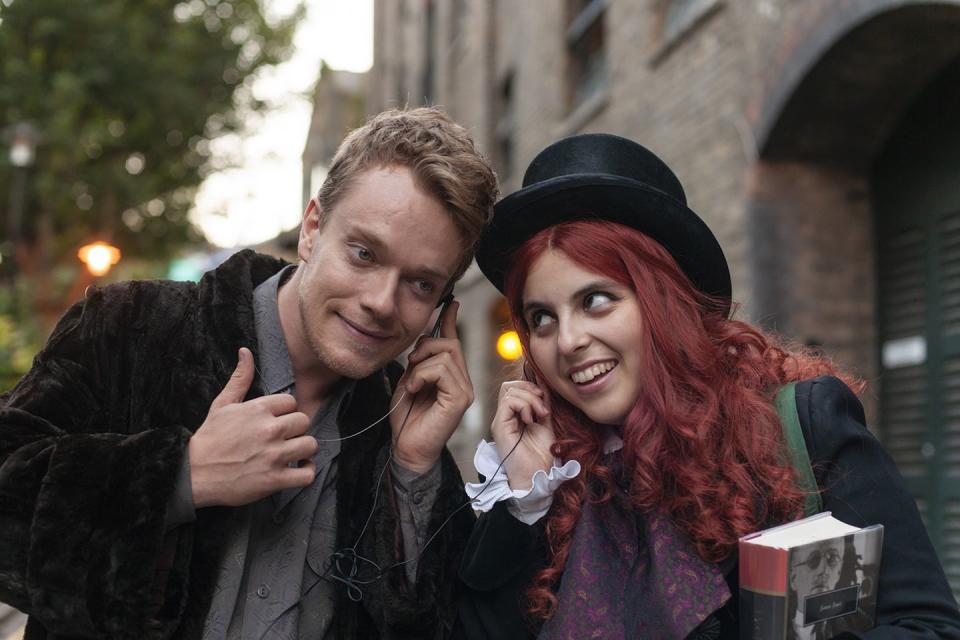Hero walls, feminism and crushes: How to Build a Girl offers a realistic look at life as a teenage girl

Less than a year ago, Coky Giedroyc was striding down the red carpet at Toronto International Film Festival. It was the world premiere of her new movie How to Build a Girl, Caitlin Moran’s adaptation of her loosely autobiographical novel, starring Beanie Feldstein as the self-actualising heroine Johanna Morrigan. Today, she is speaking to me on the phone from her garden shed (repurposed into an office) as sheets of rain crash down on the roof.
It is safe to say this is not the direction she imagined her press tour would take. Despite having to settle for a digital release of How to Build a Girl, she is in unexpectedly high spirits. “At first I was disappointed that the film won’t be coming out in the cinema,” she admits, “but our target audience is going to be very happy watching it on demand. It is playing in drive-ins in the US! All of our box office is from that, hilariously. A friend of mine took a picture of these cars camped out in front of our movie in West California. It was such a buzz, I loved it.”
Giedroyc’s film follows the working-class Wolverhampton teenager Johanna as she overcomes the limitations of, as she calls it, her “bad postcode” to land a job as a music critic at DME magazine. As its title suggests, the movie is a story of reinvention, of trying on and casting off different identities on the road to finding one’s true self.
No matter how much eyeliner she wears or fishnets she ladders, Johanna cannot disguise the fact that she is an enthusiastic teenager. The director physically manifests her lead’s zealous personality in the film through the pitch-perfect design of her bedroom. Johanna’s “god wall” is plastered with portraits of her idols (including Jane Austen, Elizabeth Taylor, Frida Kahlo and Sigmund Freud), which materialises the breadth of her varied passions; these figures even speak to her throughout the movie in a magical-realist flourish. “I love the god wall, I’m very proud of it,” says Giedroyc. “We used photos of Caitlin’s own bedroom as a reference, which had lots of pictures stuck up and drawings she’d done, things torn out of newspapers. Look at any 16-year-old girl’s bedroom. My daughter has one whole wall covered in her heroes. And I did the same when I grew up.”

How to Build a Girl offers a perceptive commentary on fangirl culture. The book notes that the DME office “is essentially built out of trousers, confidence and testicles” and this machismo translates into the movie. Johanna’s gushing praise in one feature she writes leads to her dismissal after a male colleague sniffs, “This is why we don’t employ little girls to write for our paper.” Giedroyc, although not surprised by such misogyny, finds it appalling. “Let’s be honest, boys are threatened by girls. Men are threatened by women. It’s the age-old story,” she says. “If I was being cynical, I’d say it’s a way of repressing a woman. If you dismiss someone’s optimism and joy and energy and love of life, you’re actually just squashing down all the good bits of that person. And it comes from fear. You’re getting the feminist out of me, here!”
Feminism permeates the movie, right down to its very structure. In the opening sequence, Johanna tells us in a confessional voiceover, “I do not think my adventure starts with a boy. I think it starts with me.” Although there are romantic subplots in the movie, they are just that: subplots, secondary to this young woman’s personal journey of discovery and fulfilment.

It is still rare to see selfhood as the focus in female coming-of-age movies, which tend to revolve heteronormatively around chasing boys. Why does Giedroyc think this is? “Frankly, until very recently, female characters were ciphers to the male lead,” she explains. “A romantic storyline is a neat little place where you can put a woman, but it’s a way of saying that our stories aren’t active, action-packed or heroic; it’s a way of saying our stories are passive, gentle and romantic. Johanna is an iconoclastic, messy, noisy, brave and bombastic character. She’s not your typically nice, well-behaved woman in a movie. We flipped the gaze and this is our story from our point of view.”
This female gaze is evident in How to Build a Girl’s forthright attitude towards sexuality. (“She doesn’t have sex and die of some terrible disease or get vilified. I want teenagers to know that the story is not over when you have your first bad shag!”) Admirers of Moran’s novel – which somewhat outrageously began with Johanna masturbating next to her six-year-old brother – will notice that the film does smooth over the more graphic details of her carnal escapades.
The film-maker does regret giving her protagonist’s burgeoning sex life a lighter touch onscreen. “I wish I’d had more sex in the film. I felt like we had the bare minimum compared to the book,” she admits. This decision was not a result of studio-meddling, but Giedroyc’s own intuition on what audiences could handle. “It was an instinct not to alienate people. We’re still a prudish culture really. It’s just so tiresome and two-faced,” she says, with a groan. “You can have people get their eyes popped out and throats slit and God knows what gratuitously in films and then you can’t tell a really important story about a young girl growing up. It’s just mad. Any discussions to remove the sex montage or Johanna masturbating in the film were quickly squashed by us women I can tell you. We were a fierce band.”

Having worked as a director for 30 years, Giedroyc has first-hand experience of navigating the roadblocks that force so many women out of the entertainment business. Her interest in cinema started when she was 12 and would spend Saturday afternoons watching Hitchcock marathons on television. “I never imagined for a million years I could work in this industry,” she says. “It wasn’t like I saw a movie and thought, ‘Oh, that’s me. I’m gonna do that.’ As young men would think.”
Giedroyc credits other women for giving her “all the big breaks” in her career, and now, as a seasoned film-maker, she hopes to pay it forward. “I do workshops in schools with 14- and 15-year-old girls all the time because I feel so passionately about making them aware that there are routes into directing. I mentor as well. I have young female directors shadow me. I give them a mini film school and teach them how sets work, because so often so many young women don’t get a chance to try it. I don’t know why all directors aren’t obliged to mentor to be honest. If you don’t know what the job is, how are you going to know that you can do it?”
With film production halted and schools closed due to coronavirus, Giedroyc has had to put her outreach efforts on hold for the foreseeable future. She has managed to keep busy during lockdown, though, spending hours in her shed preparing for her next film Greatest Days, a musical set to the chart-toppers of Take That.
“It’s about four women – fangirls in fact! – and what splits them apart and brings them back together in their forties.” The band have signed on as executive producers, meaning Giedroyc directly collaborates with them, an exciting prospect for an avowed fan. “I had a Zoom call with Take That the other day,” she says, conspiratorially. “I did have a bit of a flutter even though I’m way older than all of them. By the time they were popular I was having babies, so I wasn’t at the front of their gigs screaming and throwing my knickers. But I’ve loved their music always.” Like any fangirl worth her salt, Coky Giedroyc is disarmingly sincere and enthusiastic. Here’s hoping her passion won’t stay cooped up in her back garden for too much longer.
‘How to Build a Girl’ will be available to stream on Amazon Prime Video from Friday 24 July.
In need of some at-home inspiration? Sign up to our free weekly newsletter for skincare and self-care, the latest cultural hits to read and download, and the little luxuries that make staying in so much more satisfying.
You Might Also Like

